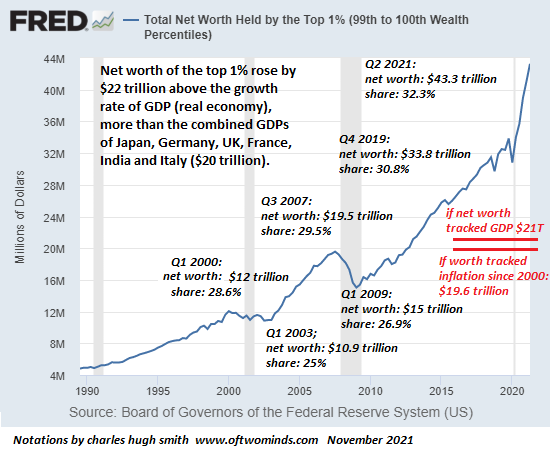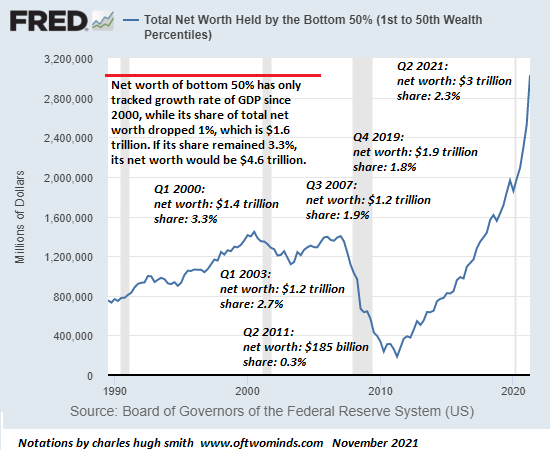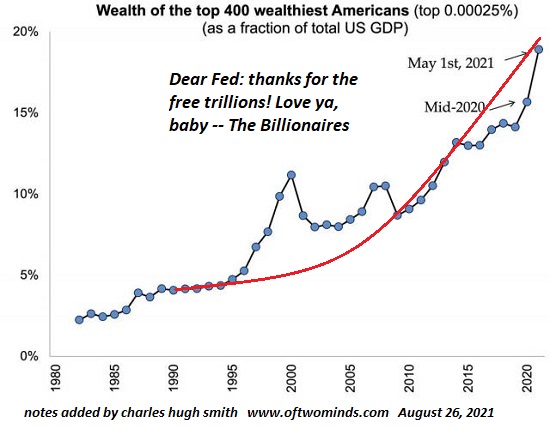
Considered that political power in America is a pay-to-play auction in which the highest bidder wins, how this incomprehensibly lopsided ownership of wealth plays out is an open question.
Wealth inequality quickly falls under an abstraction unless we contextualize it in significant ways. I’ve annotated 2 St. Louis Federal Reserve (FRED) charts– the net worth of America’s leading 1% and the net worth of America’s bottom 50% of families, approximately 66 million households– to show their net worth and their share of all family net worth, and put this in the context of inflation and GDP (gdp) of the U.S. and other nations.
These charts might look complex however the concept is really quite simple: I’ve noted how each group (the top 1% and the bottom 50%) did at the top and bottom of each bubble: the dot-com bubble in 2000, the stock/housing bubble that topped in 2007, and the current bubble, noting the pre-pandemic information at the end of 2019 and the most recent totals (second quarter 2021).
Next, I present a simple concern: if the net worth of each group had tracked the growth of America’s GDP (i.e. its real economy), where would its net worth be now? All else being equivalent, the assumption that net worth would increase basically in lockstep with the growth of the whole economy makes good sense.
I keep in mind both the dollar quantity of each group’s net worth and their share of total home wealth to track their piece of wealth relative to the entire pie of wealth and to each other’s piece. In other words, as the net worth pie expands, does each group expand its share of the pie or not?
What we find is a stunning asymmetry: if the leading 1%’s net worth has actually increased together with GDP given that 2000, it would now have to do with $21 trillion. Instead, it’s now over $43 trillion, a $22 trillion gain above where it would be had it tracked GDP development.
For context, this is bigger than the GDP of the U.S. ($21 trillion) and the combined GDPs of the six biggest economies behind the U.S. and China: Japan, Germany, UK, France, India and Italy which total about $20 trillion. It’s more than the nominal GDPs of China and Japan.
Simply put, the $22 trillion acquired by America’s top 1% as an outcome of Federal Reserve bubble-blowing is literally beyond comprehension: s sum larger than whole economies, a sum absolutely disconnected from America’s real-world economic growth.
Keep in mind that the top 1%’s share of total wealth has increased with every bubble: even as the pie of wealth expanded, the leading 1%’s share has increased to roughly one-third of all wealth, that includes lorries, homes, monetary assets, and so on (The top 1% owns the majority of all financial possessions.)
In comparison, the bottom 50%, in spite of current gains resulting from the real estate bubble, has just tracked GDP: where the top 1% more than doubled its wealth above where it would have been had it increased together with GDP, the bottom 50% have actually barely stayed up to date with GDP’s expansion. If it wasn’t for the existing real estate bubble, the bottom 50%’s wealth wouldn’t even have kept up with GDP.
The bottom 50% has lost ground in regards to its share of overall family net worth: its already-marginal 3.3% of overall wealth in 2000 has slipped to an inconsequential (i.e. signal-noise) 2.3%.
If the bottom 50% had preserved its meager 3.3% share, its net worth would be higher by $1.6 trillion– 1% of the overall net worth of U.S. households ($160 trillion). That’s 50% higher than its existing net worth of $3 trillion.
Keep in mind how the real estate bubble breaking in 2008-09 generally damaged the wealth of the bottom 50% whose primary property (if any) is a house. Net worth of the bottom 50%– over 60 million homes– fell to a near-zero $185 billion in 2011 at the nadir of the housing market.
The top 1%’s fortunes have climbed up in a series of higher lows and much higher highs: each spot of trouble (collapse of the bubble du jour) dented the net worth of the leading 1%, however their wealth never ever even declined to previous troughs. At the bottom of the oh-so horrendous market drop in 2020, the leading 1%’s wealth was still double what it had actually been at the trough in 2009, $30 trillion vs. $15 trillion.
All of this upward shift of wealth speeds up as we approach the peak of wealth-power: a handful of billionaires own more than the bottom 50% (by some procedures, the asymmetry is even worse than portrayed by FRED data.)
Given that political power in America is a pay-to-play auction in which the greatest bidder wins, how this incomprehensibly lopsided ownership of wealth plays out is an open question. The pendulum of wealth-power concentration has reached an extreme, and when it swings back, it will reach a similarly extreme position at the other end of the spectrum.




< img align ="center"src=" https://www.oftwominds.com/photos2021/networth-bottom50-11-21a.png "/ > If you found worth in this content, please join me in looking for options by ending up being a $1/month patron of my work through patreon.com.
My new book is readily available! A Hacker’s Teleology: Sharing the Wealth of Our Diminishing Planet 20% and 15% discount rates (Kindle $7, print $17, audiobook now readily available $17.46)
Read excerpts of the book totally free (PDF).
The Story Behind the Book and the Introduction.
Current Videos/Podcasts:
Keiser Report|The Catastrophe of the Treadmill (25:30)
My current books:
A Hacker’s Teleology: Sharing the Wealth of Our Diminishing World (Kindle $8.95, print $20, audiobook $17.46) Check out the first area free of charge (PDF).
Will You Be Richer or Poorer?: Revenue, Power, and AI in a Traumatized World
(Kindle $5, print $10, audiobook) Check out the first section free of charge (PDF).
Pathfinding our Destiny: Preventing the Last Fall of Our Democratic Republic ($5 (Kindle), $10 (print), ( audiobook): Read the very first area for free (PDF).
The Adventures of the Consulting Theorist: The Disappearance of Drake $1.29 (Kindle), $8.95 (print); read the first chapters totally free (PDF)
Cash and Work Unchained $6.95 (Kindle), $15 (print) Check out the very first area totally free (PDF).
End up being a $1/month patron of my work through patreon.com.
NOTE: Contributions/subscriptions are acknowledged in the order got. Your name and e-mail remain private and will not be provided to any other private, business or company.
|
Thank you, Judy W. ($54), for your marvelously generous contribution to this website– I am considerably honored by your unfaltering support and readership. |
Thank you |
, Roy S. ($5/month), for your splendidly generous subscription to this website– I am significantly honored by your support and readership. |
|
Thank you, Ralf H. ($60), for your superbly generous contribution to this website– I am considerably honored by your assistance and readership. |
Thank you |
, Keith W. ($20), for your much-appreciated generous contribution to this website– I am greatly honored by your assistance and readership. |

